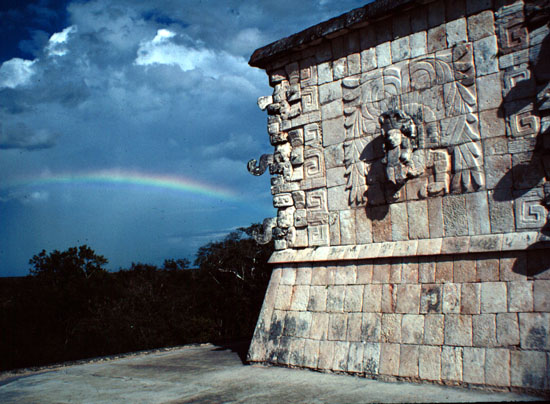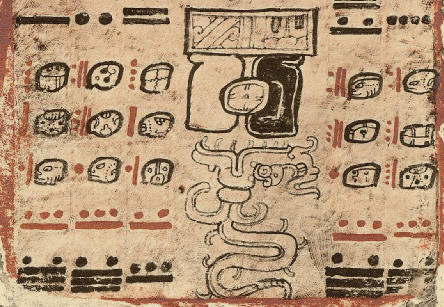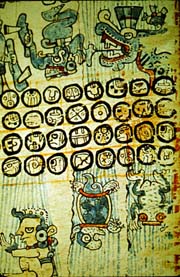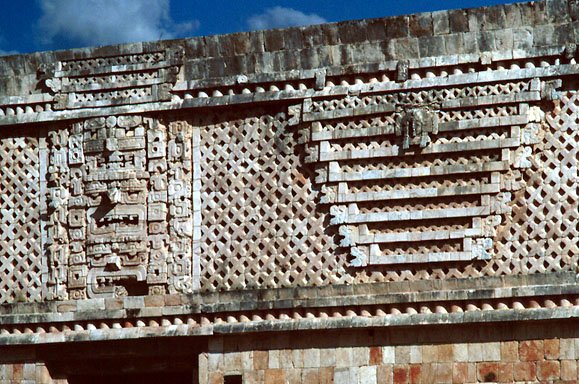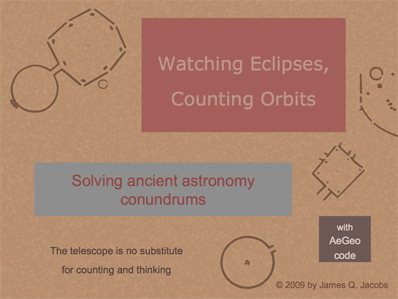|
Bibliography
Aveni, Anthony F.
1981. Archaeoastronomy in the Maya Region: A
Review of the Past Decade. Archaeoastronomy, 3,
pp. S2-S16
Aveni, Anthony F.
1979. Venus and the Maya. American Scientist,
67:274-285.
Aveni, Anthony F.
and Horst Hartung. 1991. Archaeoastronomy and the Puuc
sites. Arqueoastronomía y
Etnoastronomía en Mesoamérica. J.
Broda, S. Iwaniszewski, and L. Maupomé, eds.,
(Inst. de Investig. Hist., Serie de Hist. de la
Ciencia y la Technología, 4). México, U.
N. A. M. pp. 65-95.
Aveni, Anthony F.
and Horst Hartung. 1989. Uaxactun, Guatemala, Group E,
and similar assemblages: an archaeoastronomical
reconsideration. In World Archaeoastronomy,
edited by A. Aveni, pp. 441-461. Cambridge University
Press, Cambridge.
Brotherston, G.,
1982, Astronomical Norms in Mesoamerican Ritual and
Time-Reckoning. In Archaeoastronomy in the New
World, Edited by A. F. Aveni, pp. 109-142.
Cambridge University Press, London.
Carlson, John B.
1981. Numerology and the astronomy of the Maya. In Archaeoastronomy
in the Americas, edited by R. Williamson, pp.
205-213. Ballena Press & Center for
Archaeoastronomy. Los Altos & College Park.
Collea, Beth A.
1981. The celestial bands in Maya hieroglyphic
writing. In Archaeoastronomy in the Americas,
edited by R. Williamson, pp. 215-231. Ballena Press
& Center for Archaeoastronomy. Los Altos &
College Park.
Förstemann,
Ernst W. 1906. Commentary on the Maya manuscript
in the Royal Public Library of Dresden. Harvard
University, Peabody Museum, Papers, Vol. IV, No. 2.
Cambridge, Peabody Museum. pp. 51-267.
Galindo Trejo, J.
1990. Solar Observations in Ancient Mexico:
Malinalco. Archaeoastronomy 15: S17- S35.
Gibbs, Sharon L.
1977. Mesoamerican calendrics as evidence of
astronomical activity. Native American astronomy.
A. Aveni, ed., Austin, University of Texas Press. pp.
21-35.
Justeson, John S.,
1989. Ancient Maya ethnoastronomy: an overview of
hieroglyphic sources. In World archaeoastronomy:
selected papers from the 2nd Oxford International
Conference on Archaeoastronomy. A. Aveni, ed.,
Cambridge, Cambridge University Press. pp. 76-129.
Leon
Cázares, María del Carmen, 1994. Fray
Diego de Landa, Relacion de las Cosas de Yucatan.
Consejo Nacional para la Cultura y las Artes, Mexico,
D. F.
Lounsbury, Floyd
G., 1989. A Palenque king and the planet Jupiter. In World
archaeoastronomy. A. Aveni, ed., Cambridge,
Cambridge University Press. pp. 246-259.
Lounsbury, Floyd
G., 1982, Astronomical knowledge and its uses at
Bonampak, Mexico. (In) Archaeoastronomy in the New
World, edited by A. F. Aveni, pp. 143-168.
Cambridge University Press. London.
Lounsbury, Floyd
G., 1978, Maya numeration, computation, and
calendrical astronomy. In Dictionary of Scientific
Biography, C. Gillispie, editor., vol. 15. New
York, Scribner's. pp. 759-818.
Malmstrom, Vincent
H., 1991. Edzna: earliest astronomical center of the
Maya? In Arqueoastronomía y
etnoastronomía en Mesoamérica. J.
Broda, S. Iwaniszewski, and L. Maupomé, eds.,
(Inst. de Investig. Hist., Serie de Hist. de la
Ciencia y la Technología, 4). México, U.
N. A. M. pp. 37-47.
Marcus, Joyce,
1992. Mesoamerican Writing Systems, Princeton
University Press, Princeton.
Maupomé,
Lucrecia. Reseóa de las evidencias de la
actividad astronómica en la América
antigua. 1986. In Historia de la
astronómica en México M. Moreno
Corral, ed. México, Fondo de Cultura
Económica. pp. 17-64.
Milbrath, Susan.
1988. Astronomical images and orientations in the
architecture of Chichen Itza. In New directions in
American archaeoastronomy, A. Aveni, ed., (BAR
International Series, 454). Oxford, B.A.R. pp. 57-79.
Ponce de
León H., Arturo. 1983. Fechamiento
arqueoastronómico en el altiplano de
México. In Calendars in Mesoamerica and
Peru: Native American computations of time. A.
Aveni and G. Brotherston, eds., (BAR International
Series, 174). Oxford, B. A. R. pp. 73-99.
Ruppert, K. 1934. Explorations
in Campeche. Carnegie Institution of Washington
Yearbook. Annual Report 1933-34.
Segovia,
Víctor. 1991. La astronomía en Uxmal. In
Arqueoastronomía y etnoastronomía en
Mesoamérica. J. Broda, S. Iwaniszewski,
and L. Maupomé, eds., Inst. de Investig. Hist.,
Serie de Hist. de la Ciencia y la Technología,
4. México, U. N. A. M. pp. 61-63.
Severin, Gregory
M., 1981. The Paris Codex: Decoding an Astronomical
Ephemeris. Transactions of the American Philosophical
Society 71:5.
Thompson, J. Eric
S., 1971, Maya Hieroglyphic Writing.
University of Oklahoma. Norman.
Thurston, Hugh.
1994. A Mayan Table of Eclipses. Archaeoastronomy,
19, pp. S83-S84.
|




